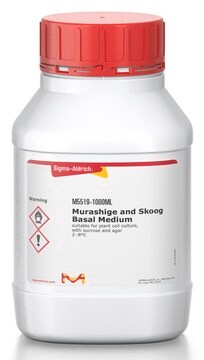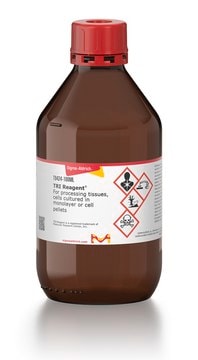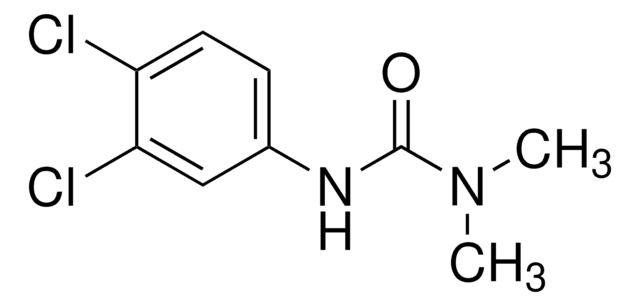H9773
Igromicina B
lyophilized powder, suitable for plant cell culture, BioReagent
Sinonimo/i:
Hygromycin
About This Item
Prodotti consigliati
product name
Igromicina B, suitable for plant cell culture, BioReagent, ≥60% (HPLC), lyophilized powder
Origine biologica
Streptomyces hygroscopicus
Livello qualitativo
Nome Commerciale
BioReagent
Forma fisica
lyophilized powder
Purificato mediante
ion-exchange chromatography
Concentrazione
≥60% (HPLC)
tecniche
cell culture | plant: suitable
Colore
faintly brown to brown
white to beige
(1) 7.1, (2) 8.8
Solubilità
H2O: soluble 50 mg/mL
ethanol: soluble
methanol: soluble
Spettro attività antibiotica
fungi
applicazioni
agriculture
Modalità d’azione
protein synthesis | interferes
Temperatura di conservazione
2-8°C
Stringa SMILE
CN[C@H]1C[C@@H](N)[C@H](O)[C@@H](O[C@@H]2O[C@H](CO)[C@H](O)[C@@H]3O[C@]4(O[C@H]([C@H](N)CO)[C@H](O)[C@H](O)[C@H]4O)O[C@H]23)[C@@H]1O
InChI
1S/C20H37N3O13/c1-23-7-2-5(21)9(26)15(10(7)27)33-19-17-16(11(28)8(4-25)32-19)35-20(36-17)18(31)13(30)12(29)14(34-20)6(22)3-24/h5-19,23-31H,2-4,21-22H2,1H3/t5-,6-,7+,8-,9+,10-,11+,12-,13+,14-,15-,16+,17+,18-,19+,20+/m1/s1
GRRNUXAQVGOGFE-XKIAHZFYSA-N
Cerchi prodotti simili? Visita Guida al confronto tra prodotti
Descrizione generale
Applicazioni
Hygromycin B from Streptomyces hygroscopicus is used for gene cloning and ectopic expression. It is also used in MS medium for the in vitro screening of transgenic plants.
Azioni biochim/fisiol
Spettro antimicrobico: L′igromicina B agisce contro batteri, funghi e cellule eucariote superiori.
Avvertenza
Nota sulla preparazione
Avvertenze
Danger
Indicazioni di pericolo
Consigli di prudenza
Classi di pericolo
Acute Tox. 1 Inhalation - Acute Tox. 2 Dermal - Acute Tox. 2 Oral
Codice della classe di stoccaggio
6.1A - Combustible acute toxic Cat. 1 and 2 / very toxic hazardous materials
Classe di pericolosità dell'acqua (WGK)
WGK 3
Punto d’infiammabilità (°F)
Not applicable
Punto d’infiammabilità (°C)
Not applicable
Certificati d'analisi (COA)
Cerca il Certificati d'analisi (COA) digitando il numero di lotto/batch corrispondente. I numeri di lotto o di batch sono stampati sull'etichetta dei prodotti dopo la parola ‘Lotto’ o ‘Batch’.
Possiedi già questo prodotto?
I documenti relativi ai prodotti acquistati recentemente sono disponibili nell’Archivio dei documenti.
I clienti hanno visto anche
Articoli
Protein synthesis is a complex, multi-step process involving many enzymes as well as conformational alignment. However, the majority of antibiotics that block bacterial protein synthesis interfere with the processes at the 30S subunit or 50S subunit of the 70S bacterial ribosome.
Antibiotic kill curve is a dose response experiment in which mammalian cells are subjected to increasing amounts of selection antibiotic
Il team dei nostri ricercatori vanta grande esperienza in tutte le aree della ricerca quali Life Science, scienza dei materiali, sintesi chimica, cromatografia, discipline analitiche, ecc..
Contatta l'Assistenza Tecnica.











